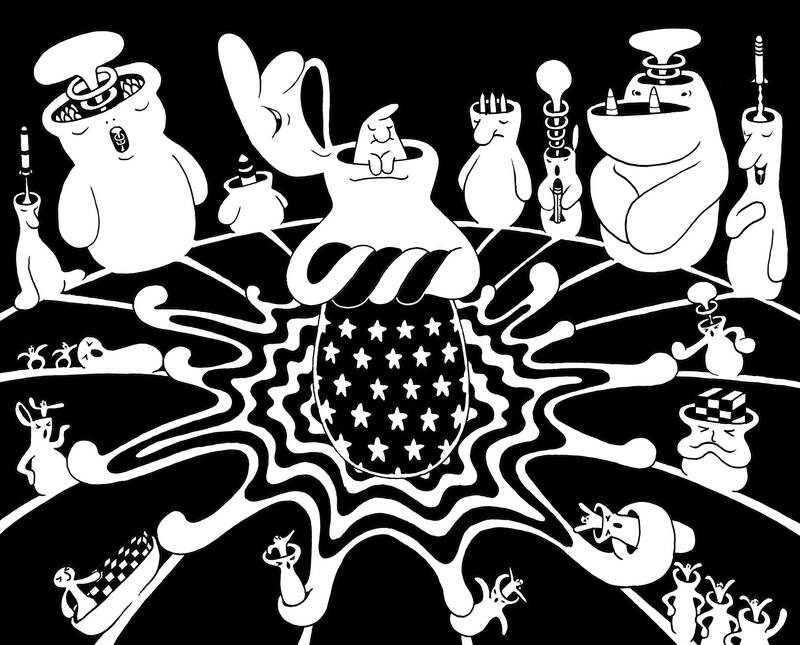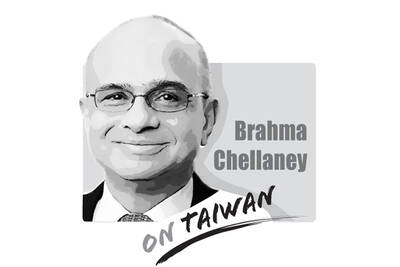Eighty years ago this August, the US bombed Hiroshima and Nagasaki, killing tens of thousands of people. Those acts helped to end World War II, but also ushered in the nuclear age.
Today, a new atomic arms race is stirring, this time not provoked by Russia, China or North Korea — who have been ramping up their arsenals — but instead by US President Donald Trump’s trade war, and his threats to withdraw the US defense umbrella. The result is a world growing more dangerous, not just for Asia, but for Americans, too.
The security architecture that helped prevent conflict from weapons of mass destruction is at risk of unravelling. For decades, Asian nations have relied on Washington’s commitment to deterrence. That is no longer guaranteed.

Illustration: Mountain People
Long-time US allies, such as Japan and South Korea, are calculating the cost — both economic and political — of developing their own arsenals. India and Pakistan have a growing supply of warheads, potentially inflaming an already volatile conflict made worse by recent tensions in Kashmir.
Trump insists that Washington has received the short end of the stick from defense deals, and that US protection is keeping the world safe while other economies benefit more. He has a point — but is also ignoring historical lessons.
The aftermath of the US’ atomic bombings prompted a recognition that such a tragedy must be avoided at all costs. So deep was the soul-searching in American society that the goal of every US president since Harry Truman has been to limit rather than encourage the spread of these weapons. Much of this was achieved through negotiated agreements and treaties.
The policies have worked. Only nine countries now possess such arsenals, even though many more have the ability to build a bomb. However, Trump is ushering in a more dangerous era. On the campaign trail in 2016, he suggested that Japan and South Korea might need to develop their own capabilities. Comments like that are influencing public opinion. A survey last year by the Korea Institute for National Unification showed that six in 10 South Koreans now favor having them.
If Seoul opts for homegrown nuclear weapons, this would lead to a domino effect, said Jamie Levin and Cho Young-won, associate professors of political science at St Francis Xavier University. Japanese public sentiment has been deeply opposed because of the nation’s painful past, but it has a full nuclear fuel cycle, allowing it in theory to fashion thousands of bombs in as little as six months, experts have said.
India and Pakistan are among the most worrying players. The risk of a conflict increased this week after a terrorist attack in Kashmir killed dozens in some of the region’s worst violence in years. So far, they have stuck to diplomatic measures as retaliation, but there is always the concern of escalation.
Even in Southeast Asia, a relative safe zone, the risks have become much more pronounced. The 1995 Treaty of Bangkok established a Southeast Asian Nuclear Weapons Free Zone, banning members from development, manufacture, acquisition or possession. However, if larger nations ramp up their arsenals, the spillover effect in Southeast Asia could force others to either look into developing their own technology, or find a new defense umbrella. Washington’s unpredictability has created a leadership vacuum that Beijing will be keen to fill.
Rather than failing to offer credible security guarantees, the US should engage with governments in Asia and address their defense ambitions. Under the administration of former US president Joe Biden, a bilateral initiative called the Nuclear Consultative Group in 2023 was launched with Seoul, which helped to quell some anxiety. Efforts like this should be expanded to other allies like Japan.
Convincing countries to stick with US deterrence strategies would be wise. Smaller nations watch what bigger countries do, not what they say. The US still has the opportunity to play global stabilizer and should not cede that role to China.
The world once looked to Washington to keep it safe. That trust is fraying. It is in the US’ interest — not just Asia’s — to rebuild it.
Karishma Vaswani is a Bloomberg Opinion columnist covering Asia politics with a special focus on China. Previously, she was the BBC’s lead Asia presenter, and worked for the BBC across Asia and South Asia for two decades. This column reflects the personal views of the author and does not necessarily reflect the opinion of the editorial board or Bloomberg LP and its owners.

As strategic tensions escalate across the vast Indo-Pacific region, Taiwan has emerged as more than a potential flashpoint. It is the fulcrum upon which the credibility of the evolving American-led strategy of integrated deterrence now rests. How the US and regional powers like Japan respond to Taiwan’s defense, and how credible the deterrent against Chinese aggression proves to be, will profoundly shape the Indo-Pacific security architecture for years to come. A successful defense of Taiwan through strengthened deterrence in the Indo-Pacific would enhance the credibility of the US-led alliance system and underpin America’s global preeminence, while a failure of integrated deterrence would
It is being said every second day: The ongoing recall campaign in Taiwan — where citizens are trying to collect enough signatures to trigger re-elections for a number of Chinese Nationalist Party (KMT) legislators — is orchestrated by the Democratic Progressive Party (DPP), or even President William Lai (賴清德) himself. The KMT makes the claim, and foreign media and analysts repeat it. However, they never show any proof — because there is not any. It is alarming how easily academics, journalists and experts toss around claims that amount to accusing a democratic government of conspiracy — without a shred of evidence. These
The Executive Yuan recently revised a page of its Web site on ethnic groups in Taiwan, replacing the term “Han” (漢族) with “the rest of the population.” The page, which was updated on March 24, describes the composition of Taiwan’s registered households as indigenous (2.5 percent), foreign origin (1.2 percent) and the rest of the population (96.2 percent). The change was picked up by a social media user and amplified by local media, sparking heated discussion over the weekend. The pan-blue and pro-China camp called it a politically motivated desinicization attempt to obscure the Han Chinese ethnicity of most Taiwanese.
On Wednesday last week, the Rossiyskaya Gazeta published an article by Chinese President Xi Jinping (習近平) asserting the People’s Republic of China’s (PRC) territorial claim over Taiwan effective 1945, predicated upon instruments such as the 1943 Cairo Declaration and the 1945 Potsdam Proclamation. The article further contended that this de jure and de facto status was subsequently reaffirmed by UN General Assembly Resolution 2758 of 1971. The Ministry of Foreign Affairs promptly issued a statement categorically repudiating these assertions. In addition to the reasons put forward by the ministry, I believe that China’s assertions are open to questions in international